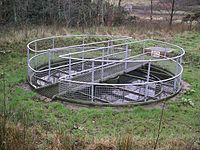
Photo from wikipedia
Abstract The textile industry discharges large amounts of polluted wastewater containing synthetic dyes. A down-flow hanging sponge (DHS) reactor is a novel aerobic wastewater treatment process that utilizes a sponge… Click to show full abstract
Abstract The textile industry discharges large amounts of polluted wastewater containing synthetic dyes. A down-flow hanging sponge (DHS) reactor is a novel aerobic wastewater treatment process that utilizes a sponge as a biomass-retaining carrier. This sponge carrier has both aerobic and anaerobic zones owing to different dissolved oxygen concentrations. In this study, the process performance of a DHS reactor treating actual textile wastewater obtained from a factory in Japan was evaluated. The effects of hydraulic retention time (HRT) and effluent recirculation (recirculation ratio = 1) on the DHS process performance were investigated. The DHS reactor showed good organic (up to 93 ± 13% of BOD) and nitrogen removal (56 ± 14% of TN) abilities during the entire experimental period. The color removal efficiencies of the DHS reactor were 55 ± 15%, 53 ± 26%, 72 ± 34%, and 35 ± 22% with HRTs of 4 h, 4 h + effluent recirculation (R = 1), 8 h + effluent recirculation (R = 1), and 8 h, respectively. Microbial community structure analysis of the DHS retained sludge showed that genus Acinetobacter was detected predominantly and reported as an azo dye-degrading bacterium. Effluent recirculation was also observed to increase the presence of aromatic-degrading bacteria and protists in the DHS reactor. These results suggest that the DHS reactor is suitable for textile wastewater treatment. Furthermore, the effluent recirculation is effective for enhancing decolorization performance.
Journal Title: Journal of water process engineering
Year Published: 2020
Link to full text (if available)
Share on Social Media: Sign Up to like & get
recommendations!